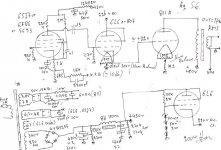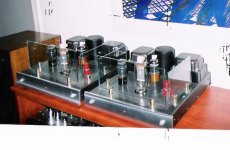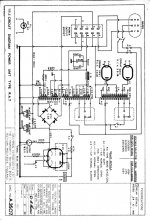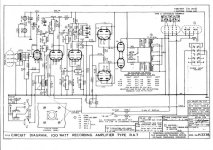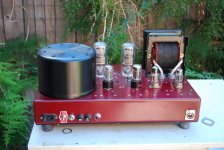Any schematics ??
Fulling,
Could you post a schematic of your prototype ?
What output transformer do you use ?
Thanks,
Jim
Fulling,
Could you post a schematic of your prototype ?
What output transformer do you use ?
Thanks,
Jim
The output trannies comes from an old Edison 60, intended for PP operation but they are airgapped to also allow EL34 PSE operation. I wired them as 5,6k/8ohms, but something like 4,5k would be better I think.
I have no schematic, but maybe I can draw one and post later.
I have no schematic, but maybe I can draw one and post later.
I tried that local feedback I talked about before by connecting a part of the OPT secondary between the 811A cathode and ground.
I have read somewhere that this would give a nice n´tight bass response, but it didn´t. Quite the opposite actually, the bass got "sloppier" than ever. I thought for a while that I had messed up the phase (positive feedback), but I guess that would have caused severe oscillations.
Today I tried regular global feedback through a resistive network between the OPT sec. and the cathode of the input tube.
This worked alot better, so I guess I´ll stick to it.
A three-way switch could be nice, allowing vaiable feedback.
I have read somewhere that this would give a nice n´tight bass response, but it didn´t. Quite the opposite actually, the bass got "sloppier" than ever. I thought for a while that I had messed up the phase (positive feedback), but I guess that would have caused severe oscillations.
Today I tried regular global feedback through a resistive network between the OPT sec. and the cathode of the input tube.
This worked alot better, so I guess I´ll stick to it.
A three-way switch could be nice, allowing vaiable feedback.
Hi All
This appears to be a really old thread. Did anybody build the 811A amplifier?
I have some 811A's lying about and would love to build an amp.
Crank
This appears to be a really old thread. Did anybody build the 811A amplifier?
I have some 811A's lying about and would love to build an amp.
Crank
I have built this:
The voltage amplifyin stage can be 6AU6 or practically any sharp cut-off pentode.
680k trimmer resistor is used to adjust the 1st. stage to minimum distortion.
An externally hosted image should be here but it was not working when we last tested it.
The voltage amplifyin stage can be 6AU6 or practically any sharp cut-off pentode.
680k trimmer resistor is used to adjust the 1st. stage to minimum distortion.
Hi artosalo. Nice looking circuit. How does it compare to a design utilizing an interstage transformer?
I have not tested with a transformer.
In such case, however, a low impedance driver stage is needed, so the use of transformer does not give any advantage.
One possibility is to replace the (6N1P) cathode follower with NMOS-fet such as IRF-820 etc.
The dynamic input resistance of 811A is about 1 kohms and required driving voltage some 10 Vrms ( @ 15 W out).
In such case, however, a low impedance driver stage is needed, so the use of transformer does not give any advantage.
One possibility is to replace the (6N1P) cathode follower with NMOS-fet such as IRF-820 etc.
The dynamic input resistance of 811A is about 1 kohms and required driving voltage some 10 Vrms ( @ 15 W out).
Hi
I have made lots of 811A PP amps, nothing comes even close. You get more than 100 watts with less than 600 volts. The 811A's last much longer than any other tube. ,I biult a pare for a friend he is still using the same tubes after 17 years. Uses 6gu7 as voltage amp and phase splitter, 6GU7/ 12BH7 as driver, 6BL7's as cathode follower, 811A's draw 70 mills. You do need good outs: 2.2kP-P Can scan circuit if any interest.
I have made lots of 811A PP amps, nothing comes even close. You get more than 100 watts with less than 600 volts. The 811A's last much longer than any other tube. ,I biult a pare for a friend he is still using the same tubes after 17 years. Uses 6gu7 as voltage amp and phase splitter, 6GU7/ 12BH7 as driver, 6BL7's as cathode follower, 811A's draw 70 mills. You do need good outs: 2.2kP-P Can scan circuit if any interest.
Multi
Would be very interested in your schematic.
Ejam
I have been playing with a 811A SE amp for 10 years.
Attached is the latest schematics for your reference.
Attachments
811a PP amp
Hi
I have scanned the original Grampian 811A circuit, record cutting amp.
I saved the parts for this amp from going to the tip, plus a heap of western electric Se 300B amps which i sold to Japan.
I have simplified the amp, there is no need for the EF86 pre-amp.so the first tube is the 6GU7/12Bh7. I also removed all the caps for stopping oscillation, only used the filter on the first 6GU7; I use 4.7K and 500Pf. The original used 26Db feedback so it needed a lot of compensation, I have found 6Db feedback plenty. The original partridge c core out put transformer 2.2K A-A weighs 9 kilos.
The power supply uses Mercury vapour rectifiers and choke input. I have made some of these amp using choke input, but with a silicon bridge rectifier. You need two 6.3volts 6 amps for the 811A’s; I use Dc but hope to use Rod Colemans Filament regulators . You need a separate 6.3v 4 amp winding for the 6BL7 and a 6.3v 3amp for the two 6GU7’s. I have found you don’t need Dc for the driver tubes.
I have built the amp using separate power supplies weighing 50 kilo’s. The mono block pictured uses a toroidal transformer and a 5K A-A with cathode feedback.
I used a Sowter 2.2K out put transformer similar to the one used for 4 x 6550’s but without the ultra linear taps. The Hammond 1.9K A-A would be a lot cheaper. Purchased two but have not had the time to try it.
I can send you the details for the power transformer, using silicon rectifiers.. You need about 590 volts Hi tension. Don’t go any higher as the 811A must have 70Ma current draw. You can use the 572-160 at higher voltages. 100 wats is plenty with this amp, friend of mine uses an 811A amp with speakers that recommend 200 watts solid state and it handles it no trouble at all, he has used the same tubes for 17 years. 6550 amps running 100 watts would be lucky to last two years.
You must have a delay relay or HT switch to allow the heaters to reach full temperature, before turning on the HT.
Phil
I found the following on DYI Audio; PP Amp using 811A
http://www.triodeel.com/gothamp.gif
Hi,
Gotham Audio made a push pull class A2 cutting head amp using 811A tubes with a B+ of 550 - 560 volts, I think Triode Electronics has a schematic for it in their "dusty files" section of their website.
Anyway, I built a pair of these amps using the Hammond 1650 series of transformers and was blown away by their sound. I used the 60 watt Hammonds rated at 4300 ohms primary but you can also use the 1650R (I think) that's rated at 100 watts with a 5K primary.
I don't think that they will do 100 watts but you can get 50 watts/channel from them. Since they are class A2 they will sound much more powerful than 50 watts.
They are a little out of the ordinary to set up but they don't use crazy voltages and can be made pretty compact. I am using 6.3vac on the filaments with absolutely no hum at the output and the power supply is pretty straight forward to build. I used a differential amp (a la Curcio) driving the 6BX7 cathode followers which in turn directly drives the 811A's. The original front end of this Gotham amp I feel is overly complicated and better results can be had with a simpler driver.
I feel this amp will put any 807 amp to shame and won't be that much harder to build. Keep the 807's for a guitar amp.
Bottom line... when using the 811A at lowish voltages, you don't need a very high primary impedance output transformer, so anything commonly available should work fine. Of course, if you want to spend money on the good stuff, all the better the results will be.
To get an idea where I am coming from, I really like triode amps for stereo use, all the better if all voltages are regulated (b+, bias, etc). I like permalloy and other exotic core materials for transformers, you know... the good stuff.
But the Gotham Audio 811A amp scheme is excellent without having to resort to exotic tricks and high dollar parts.
Hope this helps...
Good luck,
Daniel
Hi
I have scanned the original Grampian 811A circuit, record cutting amp.
I saved the parts for this amp from going to the tip, plus a heap of western electric Se 300B amps which i sold to Japan.
I have simplified the amp, there is no need for the EF86 pre-amp.so the first tube is the 6GU7/12Bh7. I also removed all the caps for stopping oscillation, only used the filter on the first 6GU7; I use 4.7K and 500Pf. The original used 26Db feedback so it needed a lot of compensation, I have found 6Db feedback plenty. The original partridge c core out put transformer 2.2K A-A weighs 9 kilos.
The power supply uses Mercury vapour rectifiers and choke input. I have made some of these amp using choke input, but with a silicon bridge rectifier. You need two 6.3volts 6 amps for the 811A’s; I use Dc but hope to use Rod Colemans Filament regulators . You need a separate 6.3v 4 amp winding for the 6BL7 and a 6.3v 3amp for the two 6GU7’s. I have found you don’t need Dc for the driver tubes.
I have built the amp using separate power supplies weighing 50 kilo’s. The mono block pictured uses a toroidal transformer and a 5K A-A with cathode feedback.
I used a Sowter 2.2K out put transformer similar to the one used for 4 x 6550’s but without the ultra linear taps. The Hammond 1.9K A-A would be a lot cheaper. Purchased two but have not had the time to try it.
I can send you the details for the power transformer, using silicon rectifiers.. You need about 590 volts Hi tension. Don’t go any higher as the 811A must have 70Ma current draw. You can use the 572-160 at higher voltages. 100 wats is plenty with this amp, friend of mine uses an 811A amp with speakers that recommend 200 watts solid state and it handles it no trouble at all, he has used the same tubes for 17 years. 6550 amps running 100 watts would be lucky to last two years.
You must have a delay relay or HT switch to allow the heaters to reach full temperature, before turning on the HT.
Phil
I found the following on DYI Audio; PP Amp using 811A
http://www.triodeel.com/gothamp.gif
Hi,
Gotham Audio made a push pull class A2 cutting head amp using 811A tubes with a B+ of 550 - 560 volts, I think Triode Electronics has a schematic for it in their "dusty files" section of their website.
Anyway, I built a pair of these amps using the Hammond 1650 series of transformers and was blown away by their sound. I used the 60 watt Hammonds rated at 4300 ohms primary but you can also use the 1650R (I think) that's rated at 100 watts with a 5K primary.
I don't think that they will do 100 watts but you can get 50 watts/channel from them. Since they are class A2 they will sound much more powerful than 50 watts.
They are a little out of the ordinary to set up but they don't use crazy voltages and can be made pretty compact. I am using 6.3vac on the filaments with absolutely no hum at the output and the power supply is pretty straight forward to build. I used a differential amp (a la Curcio) driving the 6BX7 cathode followers which in turn directly drives the 811A's. The original front end of this Gotham amp I feel is overly complicated and better results can be had with a simpler driver.
I feel this amp will put any 807 amp to shame and won't be that much harder to build. Keep the 807's for a guitar amp.
Bottom line... when using the 811A at lowish voltages, you don't need a very high primary impedance output transformer, so anything commonly available should work fine. Of course, if you want to spend money on the good stuff, all the better the results will be.
To get an idea where I am coming from, I really like triode amps for stereo use, all the better if all voltages are regulated (b+, bias, etc). I like permalloy and other exotic core materials for transformers, you know... the good stuff.
But the Gotham Audio 811A amp scheme is excellent without having to resort to exotic tricks and high dollar parts.
Hope this helps...
Good luck,
Daniel
Attachments
Grampian Circuit
Multi
Much appreciated your comments on the 811A amp. A small favour to ask though, can you post the circuits as pdf files or email me a copy. The quality of the thumbnails makes it very hard if not impossible to read some of the component values and operating voltages. Much appreciated if you could.
Regards
Ejam
Multi
Much appreciated your comments on the 811A amp. A small favour to ask though, can you post the circuits as pdf files or email me a copy. The quality of the thumbnails makes it very hard if not impossible to read some of the component values and operating voltages. Much appreciated if you could.
Regards
Ejam
This tube was mostly used in radio and quite likely run in class B.
The Altec 1570B used them, P-P Class B.
This tube was mostly used in radio and quite likely run in class B.
SV811-10/ 811-3 is made for audio. This tube is somewhat based on 811A structure. Does anyone take comparison on sound quality between these 2 tubes ?
Personally I use 6FD7 (unit 1 directly couples to unit 2) and IT 5k:5k for driver SV811-10 with 550V/ 65mA, negative bias. So first 3-4W, tube run class A1, then run class A2 for 4W more.
Sound is so good.
Last edited:
I have a plan of using IRF840 driver for 811A. does anyone give me a suggestion ? tks.
Last edited:
I have a plan of using IRF840 driver for 811A. does anyone give me a suggestion ? tks.
Below is a tube version.
Just replace the dual triode driver 6N1P with IRF820.
IRF840 has higer input capacitance. Therefor IRF820 is better.
(Though the fet is connected as source follower and input capacitance is therefore small)
An externally hosted image should be here but it was not working when we last tested it.
Michimori-san's regulated cf 811a se: swap 6080 for 5998 driver?
Greetings Michimori-san,
I'm very interested in your 811a SE amplifier in which you use a constant current source/cathode follower driver (5998) . I plan to use SV572-160 tubes in place of the 811a since they appear to be equivalent, and I have a pair on the shelf. But I have a question: do you think I could use 6080 tubes in the driver stage instead of 5998's? 5998's are quite expensive so I am looking for alternatives. I'm not an engineer and have only been working with tube circuits for about 3 years, but it looks to me like I could drop the driver plate voltage to about +75 to 100v and the CCS grid/cathode voltage to about -75 to 100V and get the same 40-45 mA through the driver. Do you think this would work? Would I need to adjust the 6080 cathode resistor? Thank you in advance for any advice you can provide.
(Your amplifier):
811A 24W SE AMP 2000
Greetings Michimori-san,
I'm very interested in your 811a SE amplifier in which you use a constant current source/cathode follower driver (5998) . I plan to use SV572-160 tubes in place of the 811a since they appear to be equivalent, and I have a pair on the shelf. But I have a question: do you think I could use 6080 tubes in the driver stage instead of 5998's? 5998's are quite expensive so I am looking for alternatives. I'm not an engineer and have only been working with tube circuits for about 3 years, but it looks to me like I could drop the driver plate voltage to about +75 to 100v and the CCS grid/cathode voltage to about -75 to 100V and get the same 40-45 mA through the driver. Do you think this would work? Would I need to adjust the 6080 cathode resistor? Thank you in advance for any advice you can provide.
(Your amplifier):
811A 24W SE AMP 2000
Attachments
I have not tried the 6080 for use in SE 811a amps but they where very micro-phonic; when I tried them in a PP amp; I would think the 5998 would be even worse. the most micro phonic was the 6080 with carbon plates. i use horn speakers maybe you would getaway with some speakers.
I find the 6BL7 is much better and they are cheap.
Phil
I find the 6BL7 is much better and they are cheap.
Phil
- Status
- Not open for further replies.
- Home
- Amplifiers
- Tubes / Valves
- 811a Class A2
